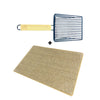Maybe you’re a brand-new cat parent, or maybe you’re a longtime feline friend. Regardless, we’re glad you’re part of the Catalyst family, and congratulations on finding the perfect cat litter!
Even with this match made in kitty litter heaven, there can be bumps along the road if your litter box cleaning schedule doesn’t meet the needs of your furry friend(s).
Remember, cleanliness and happiness go hand in hand, particularly when we’re talking about your home’s litter boxes.
A litter box is your kitty’s bathroom, and just like humans, your cats like a clean place to do their business. Keeping this space hygienic and comfortable will minimize unpleasant odors, reduce instances of kitties eliminating outside the litter box, and prevent a whole host of other issues.
Here’s the scoop:
Recommended tools:
- Litter boxes: one more than the number of cats in your household is a good rule of thumb
- Scoops: have a slotted scoop near each litter box to allow clean litter to sift back into the box; Catalyst litter scoops have wide slots, which work best for our Catalyst litter!
- Lidded trash can lined with a biodegradable bag (or biodegradable bags on hand): for depositing used litter and containing odors, and specifically designed for feline waste.
- Broom + dustpan or vacuum: to easily clean up any litter that ends up outside the box
Daily:
Scoop the litter box at least daily, if not more often.
Daily scooping keeps odors at bay, encourages your cat to excrete in the litter box and not elsewhere in your home, and to keep bacteria and other nasties out of your home – for your sake and your kitty’s.
Catalyst’s clumping litter is simple to scoop, with minimal mess. It leaves behind unused litter, so a bag of Catalyst will last as long as possible. Dispose of the used litter in the designated trash can and add fresh litter to replace what you scooped.
Wash your hands thoroughly after this process!*
Biweekly or Monthly:
Even with daily scooping, some liquid or solid waste particles can be left behind, causing odors and possible bacterial issues. Ideally, the entire litter box is changed out and deep cleaned monthly. If it’s an infrequently used litter box, you may be able to extend the time between deep cleans even longer.
- Empty all litter into a trash bag
- Remove remaining residue and dust from the litter box
- Clean the box using hot water and mild, unscented detergent
- Thoroughly rinse and completely dry the litter box
- Refill with fresh litter
- Notice how happy your furry friends are with their squeaky-clean litter box
*Important note: Immunocompromised people and pregnant women should never clean the litter box due to the risk of toxoplasmosis.
Summary:
Regardless of best practices and guidelines, your nose is your best friend when it comes to a cleaning schedule. If the litter box has some stinky odors emanating from it, it’s time to clean!
If your litter box still smells after your deepest deep clean, then it’s likely time to get a new litter box.















